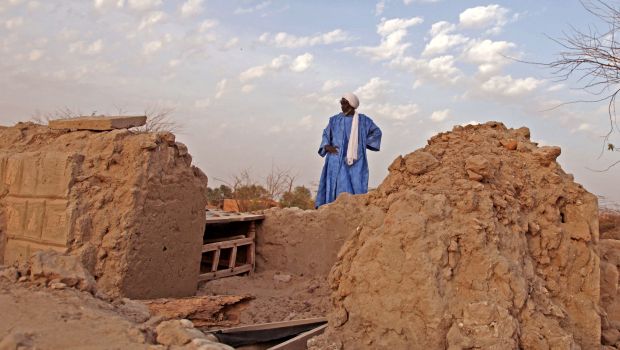
In this Friday, April 4, 2014, file photo, head mason Alassane Ramiya inspects the remains of tombs at a mausoleum after it was damaged in Timbuktu, Mali.
The emotional drama, revolving around the takeover in 2012 of the town in northern Mali by Al-Qaeda militants, was also the only film by an African director to be selected to compete for the Palme d’Or at the Cannes Film Festival in May, but failed to scoop the main prize. It did, however, win the Prize of the Ecumenical Jury and the François Chalais Prize, which honors journalists at the festival.
In preparation for its Oscars entry, the film was screened at Nouakchott’s 7th short film festival in the Mauritanian capital. The festival is organized by the House of Mauritanian Filmmakers, in collaboration with the Ministry of Culture. The premiere was attended by Mauritanian President Mohamed Ould Abdel Aziz and several ministers.
Mauritanian Minister of Culture Fatima Vall Mint Soueinae said the eagerness of the President and other government figures to attend the film screening “should delight notable writers, thinkers and intellectuals.” She announced that her ministry was now working towards “publicizing [Mauritanian] culture and art by working out a comprehensive cultural strategy that will allow them to function as messages of cultural variation, national unity, peace and constructive dialogue.”
Praising the director, Soueinae said Mauritania “is celebrating the [work] of one of [our own] who has conquered world arenas with his wonderful cinema,” adding that Sissako “has opened the horizons for Mauritanian cinema with Timbuktu and other films through which Mauritania’s . . . art has gained the international stature it deserves.”
The 97-minute film explores the historical town that was once a prominent incubator of Islamic history and culture in western Africa but became a ghost town dominated by hardline Islamists who enforced their strict law on the few remaining residents.
The film, which was produced by a French businesswoman and was filmed and acted by a large cast from 35 countries, was shot in Oualata, an old historical town in the south east of Mauritania with strong connections to Timbuktu. Sissako benefited from the similarities shared between the two cities, especially their desert environment and blend of African and Islamic architecture.
Although the struggle between the town’s residents and the new invaders form the core of the film’s events, grievances within Mauritanian culture also surface. Frictions are displayed between black Africans and the Tuareg Arabs, farmers and fishermen, and also between different generations. Sissako said he highlighted these elements as an attempt to shed light on “an exceptional town.”
